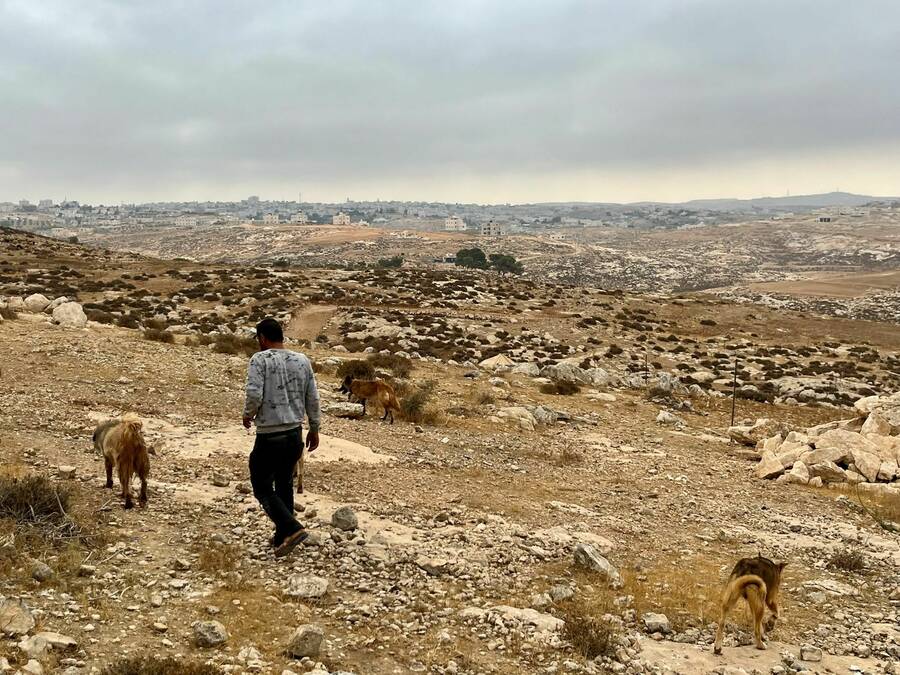The End of Widady
Settler attacks are rapidly depopulating Palestinian communities in Area C of the West Bank.

Saleh Abu ‘Awad with his animals outside the Palestinian town of a-Samu’, after he fled from his home in Widady.
(This article previously appeared in the Jewish Currents email newsletter; subscribe here!)
On June 27th, Saleh Abu ‘Awad was tending his flock on the sand-colored hills of Widady a-Tahta when two armed Israeli settlers arrived at the West Bank hamlet. The settlers threatened Abu ‘Awad with handguns and attempted to steal his sheep, according to testimony Abu ‘Awad gave to the Israeli human rights organization B’Tselem.
This was not the first settler attack on the Abu ‘Awad family, whose roughly two dozen members made up the entirety of the small shepherding community of Widady, located at the southernmost edge of the South Hebron Hills. In late December 2022, two armed settlers entered Widady and assaulted Abu ‘Awad and his brother, Radwan, as they tended to their livestock enclosures. “From December to March, the settlers came weekly on Saturday,” Abu ‘Awad told Jewish Currents. “They would come with guns while I was in the field and threaten my family.” More than once, members of the family tried to approach the authorities, but to no avail. After the assaults in December, Radwan went to file a complaint with Israeli police in the Jewish settlement of Kiryat Arba, but the police accused Radwan of instigating the settler attacks and refused to accept his complaint. Israeli anti-occupation activists soon began accompanying Abu ‘Awad and his flock in order to help shield them from harassment by settlers and the army, but the attacks continued. In the first week of March, a settler drove through Abu ‘Awad’s field and into the family’s flock of sheep. And in the early morning of March 12th, three Israeli settlers, accompanied by an Israeli soldier, broke into the family’s home, vandalized it, and threatened to kill Abu ‘Awad if he returned to his fields with the Israeli activists.
By the time the June attack took place, Abu ‘Awad said in his testimony to B’Tselem, the family had realized “that this place is no longer safe . . . I’m afraid the settlers will burn down our homes, just like they did in Huwara and Turmus Ayya.” Unwilling to live in perpetual fear, on July 16th, the residents of Widady a-Tahta dismantled their own homes, loaded their belongings onto the backs of trucks, and left the land on which they had lived for half a century. “My grandfather started this community,” Awad said of Widady in between puffs of a cigarette as we stood in the rocky valley where he had taken up temporary refuge with his flock. The sonic booms of Israeli jets rumbled overhead. “No words can describe what is happening.”
The forced depopulation of Widady is not an anomaly but, in fact, part of an emerging phenomenon. Faced with constant threat of settler attack, entire Palestinian communities in Area C—the roughly 60% of the West Bank’s territory which is under full Israeli control—are fleeing their land. According to B’Tselem, in just one area of the West Bank, east of the city of Ramallah, four Palestinian communities have been forced off their land by settler violence, including the community of Ras a-Tin, whose roughly 120 residents left their homes in July 2022. In May 2023, Palestinian journalist Basel Adra reported that the 27 families of the village of ‘Ein Samia “dismantled their own homes” after “months of escalating settler violence.” This August, the Palestinian Bedouin community of al-Qabun packed their belongings and fled. “There are almost no Palestinians remaining in a vast area stretching east of Ramallah to the outskirts of Jericho,” journalist Oren Ziv wrote in a detailed report for +972 Magazine about the depopulation of this large swath of the central West Bank. “Most of the communities who lived in the area—which covers around 150,000 dunams, or 150 square kilometers of the occupied West Bank—have fled for their lives in recent months as a result of intensifying land seizures, backed by the Israeli army and state institutions.” The expulsion of Widady, in the South Hebron Hills, suggests this process is unfolding in other parts of the West Bank too.
Whether in the region east of Ramallah or in the hills south of Hebron, the settler’s systematic approach appears to be the same. After compiling testimony from several recently displaced Palestinian communities, Ziv described the settlers’ basic mode of operation: Under the permissive eye of the army, settlers establish an outpost or bring their flocks to graze on land that Palestinian communities have long used as grazing grounds; “then armed settlers proceed to harass them day and night, even entering houses, without the army or police intervening.” This was precisely how settlers drove the Abu ‘Awad family out of Widady. Israeli policy enabled the construction of two outposts and the Meitarim industrial zone, which squeezed the Widady on its east and west sides. “The state takes the hills,” journalist Basel Adra told Jewish Currents, referring to the Israeli government’s seizure of Palestinian land and its greenlighting of outposts. “This enables the settlers to take the valleys.”
Recent efforts to displace Palestinian communities in Area C are an intensification of longstanding Israeli policy. In a statement B’Tselem released in August after the depopulation of al-Qabun, the human rights group charged that Israeli policies “force impossible conditions on local residents in order to push them to leave”—a process that has continued regardless of the political composition of the government in power. Israel refuses to connect Palestinian communities Area C to essential water and electricity infrastructure or to paved roads, and many Palestinian-owned structures face the threat of demolition for having been built without permits, which are functionally impossible for Palestinians to obtain. “Even without the settlers, living conditions here are very difficult,” Abu ‘Awad recalled in his testimony to B’Tselem. “There are no medical clinics or schools.” Abu ‘Awad said that children from Widady had to travel six miles to the nearby town of a-Samu’ to attend school, and they often had to stay with Abu ‘Awad’s brother during the week. The family also had to seek healthcare elsewhere. “When my wife was pregnant, she had contractions while traveling on the dirt road to the hospital in Yatta,” Abu ‘Awad told B’Tselem. She did not return to the village for some time after the birth, partly due to fear of settler violence.
Still, the residents of Widady had managed to live in Area C despite the harsh conditions. It was the recent and growing danger posed by encroaching settlers that made their situation unlivable. While settlers have built outposts and carried out attacks under previous Israeli governments, the elevation of the settler and Kahanist right to positions of state power has increased the frequency and destructiveness of the attacks. Support from politicians like Israeli Finance Minister Bezalel Smotrich and National Security Minister Itamar Ben-Gvir has emboldened settler violence. After Israeli police arrested two far-right settler militants suspected of murdering a Palestinian teenager in the village of Burqa, Ben-Gvir praised the assailants, tweeting that “a Jew who defends himself and others from murder by Palestinians is not a murder suspect but a hero who will get full backing from me.”
The hilltop settlers are the armed wing of the political movement represented by hard right politicians like Smotrich and Ben-Gvir, and their attempts to expel Palestinians in Area C are best understood in relation to the movement’s ultimate goal. In a 2017 article for the right-wing Israeli magazine Hashiloach, Smotrich laid out his blueprint for the eventual Israeli annexation of the West Bank and the expulsion of the Palestinians who resist the application of Israeli sovereignty. The “first and most important stage,” he wrote, would be “victory by settlement”: the building of outposts, towns, cities, and Jews-only roads and infrastructure, with the aim of reaching one million settlers in the West Bank. The forced displacement of villages like Widady is the corollary to this expansive vision of settlement, its necessary and desired outcome. For the aim of “victory by settlement,” Smotrich writes, is to destroy the potential geographic contiguity of any future Palestinian state in the West Bank and to “imprint upon the consciousness of the Arabs and the world that an Arab state will never arise in this land.” Outpost by outpost, depopulated village by depopulated village, Israel’s government, hand-in-hand with the settlers, seems to be making Smotrich’s dream a reality.
Meanwhile, Palestinians displaced by the settler violence have fewer and fewer places to go as they seek to maintain their traditional livelihood. Since his departure from Widady a-Tahta, Abu ‘Awad has been unable to find a new permanent home. He first moved near the Israeli settlement of Shim’a, but the Israeli civil administration—which oversees military rule in the West Bank—ordered him to leave. He then tried to move back to Widady, but the settlers came back to bother him, so he left. Abu ‘Awad sent his family, his eight children and two wives, to live in the urbanized town of a-Samu’ with his brother, but he cannot live there, he said, “because I need to keep an eye on the sheep” which now graze in the valley adjacent to a-Samu’. He won’t be able to stay between the hills of a-Samu’ for long, either: While there were two wells in Widady, now he must fill a yellow tank with water every day to ensure his livestock—roughly 150 sheep, 18 goats, half a dozen dogs— survive. The valley also does not offer enough space for his flock, Abu ‘Awad said. And as in Widady, there is still the threat of nearby settlers.
If he cannot find new land for his flock to graze, Abu ‘Awad will face a choice: sell part of his flock so that he can build a new enclosure in which to house the rest, or abandon shepherding entirely. Choosing the latter would mean that Abu ‘Awad, like many other Palestinians, would have to look for work in construction or agriculture, most likely inside the Green Line if he can get a permit. For generations, small Palestinian communities across the West Bank have relied on shepherding for their livelihoods. The Israeli authorities and settlers together, Abu ‘Awad said, “are destroying the shepherding way of life.”
Joshua Leifer is a member of the Dissent editorial board. His essays and reporting have also appeared in The Guardian, The Nation, Jacobin, +972 Magazine, and elsewhere.

